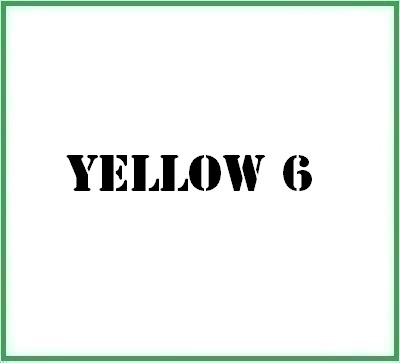Yellow 6 is a chemical compound, a synthetic azo dye.
The name describes the structure of the molecule
- "Yellow" indicates the color of the dye.
- "6" is a number that specifically identifies this yellow dye among other yellow dyes.
Description of raw materials used in production
- Aniline - An organic compound derived from petroleum.
- Naphthalene-1-sulfonic acid - An aromatic organic acid.
- Naphthalene-2-sulfonic acid - Another aromatic organic acid.
Step-by-step summary of industrial chemical synthesis process.
- Preparation - Aniline is mixed with naphthalene-1-sulfonic acid to form a solution.
- Diazotization - The solution is diazotized by treating it with sodium nitrite in an acidic environment.
- Coupling - The resultant diazo compound is then reacted (coupled) with naphthalene-2-sulfonic acid.
- Purification - The crude product obtained is purified through various methods like filtration, crystallization, and washing.
- Drying - The purified dye is dried to remove any residual moisture.
- Quality Control - A quality check is done on the dye to ensure it meets the desired specifications.
It appears in the form of a yellow powder

What it is for and where
Cosmetics
It is a restricted ingredient as a Relevant Item in the Annexes of the European Cosmetics Regulation 1223/2009. Substance or ingredient reported: Disodium 6-hydroxy-5-[(4-sulphonatophenyl)azo]naphthalene-2-sulphonate and its insoluble barium, strontium and zirconium lakes, salts and pigments
Colorant. This ingredient has the function of colouring the solution in which it is inserted in a temporary, semi-permanent or permanent manner, either alone or in the presence of the complementary components added for colouring.
Safety
The problem with azo dyes (monoazo or diazo) is photocatalytic degradation (1) leading to oxidation and the subsequent formation of impurities such as aromatic amines (2), some of which have carcinogenic activity.
- Molecular Formula C12H11N3O3S
- Molecular Weight 277.298 g/mol
- CAS 104-23-4
- EC number 220-491-7
Synonyms:
- Ci 15985
- Aminoazobenzenesulfonic acid
- 4'-aminoazobenzene-4-sulphonic acid
- 4-[(4-aminophenyl)diazenyl]benzenesulfonic acid
- 4-[(E)-2-(4-aminophenyl)diazen-1-yl]benzene-1-sulfonic acid
- C.I. 13011 (Free acid)
- MDL number MFCD00035778
References_____________________________________________________________________
(1) Li M, He W, Liu Y, Wu H, Wamer WG, Lo YM, Yin JJ. FD&C Yellow No. 5 (tartrazine) degradation via reactive oxygen species triggered by TiO2 and Au/TiO2 nanoparticles exposed to simulated sunlight. J Agric Food Chem. 2014 Dec 10;62(49):12052-60. doi: 10.1021/jf5045052. Epub 2014 Nov 24. PMID: 25393426.
Abstract. When exposed to light, TiO2 nanoparticles (NPs) become photoactivated and create electron/hole pairs as well as reactive oxygen species (ROS). We examined the ROS production and degradation of a widely used azo dye, FD&C Yellow No. 5 (tartrazine), triggered by photoactivated TiO2 NPs. Degradation was found to follow pseudo-first order reaction kinetics where the rate constant increased with TiO2 NP concentration. Depositing Au on the surface of TiO2 largely enhanced electron transfer and ROS generation, which consequently accelerated dye degradation. Alkaline conditions promoted ROS generation and dye degradation. Results from electron spin resonance spin-trap spectroscopy suggested that at pH 7.4, both hydroxyl radical (•OH) and singlet oxygen ((1)O2) were responsible for dye discoloration, whereas at pH 5, the consumption of (1)O2 became dominant. Implications for dye degradation in foods and other consumer products that contain both TiO2 and FD&C Yellow No. 5 as ingredients are discussed.
(2) Belai N, White SR. Determination of Unsulfonated Aromatic Amines in FD&C Yellow No. 5 and FD&C Yellow No. 6 by Liquid Chromatography-Triple Quadrupole Mass Spectrometry. J AOAC Int. 2019 Mar 1;102(2):580-589. doi: 10.5740/jaoacint.18-0165.
Abstract. Background: This paper describes a simple and sensitive ultra-HPLC-triple quadrupole MS (LC-MS/MS) method for the determination of six unsulfonated aromatic amines in the color additives FD&C Yellow No. 5 (Y5) and FD&C Yellow No. 6 (Y6). The six amines determined by this method are aniline (ANL), benzidine (BNZ), 4-aminobiphenyl (4ABP), 4-aminoazobenzene (4AAB), 2-aminobiphenyl (2ABP), and 4-aminobenzonitrile (4ABN). Objective: This method is intended for use in batch certification of the color additives by the U.S. Food and Drug Administration (FDA) to ensure that each lot meets published specifications for coloring foods, drugs, and cosmetics. Methods: A modified quick, easy, cheap, effective, rugged, and safe (QuEChERS) procedure is used for extraction of the amines. Quantitative determination was performed in electrospray positive ionization and multiple-reaction monitoring modes. Results: Validation of the method demonstrated overall recovery of 101-115% and precision of 1.74-9.78% for all analytes. Excellent regression coefficients were obtained, with values >0.999. Conclusions: The validated method was successfully used for the analyses of 30 Y5 and Y6 samples and provided results that are consistent with results from the current method used by FDA, with greater sensitivity and low matrix effects. Highlights: The validation results demonstrate that the new LC-MS/MS method is applicable for use in routine batch certification.
![]() Yellow 6
Yellow 6 


